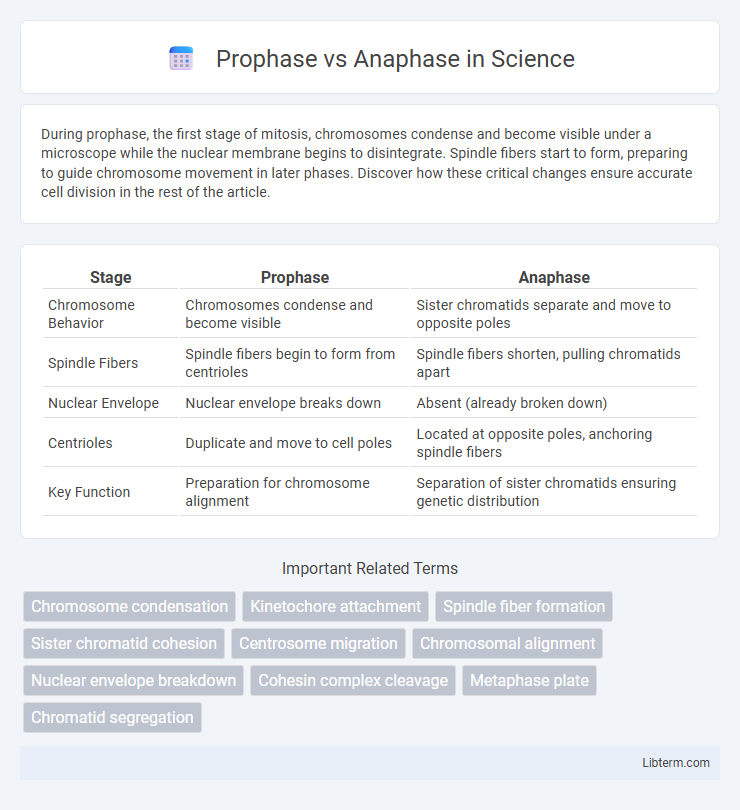During prophase, the first stage of mitosis, chromosomes condense and become visible under a microscope while the nuclear membrane begins to disintegrate. Spindle fibers start to form, preparing to guide chromosome movement in later phases. Discover how these critical changes ensure accurate cell division in the rest of the article.
Table of Comparison
| Stage | Prophase | Anaphase |
|---|---|---|
| Chromosome Behavior | Chromosomes condense and become visible | Sister chromatids separate and move to opposite poles |
| Spindle Fibers | Spindle fibers begin to form from centrioles | Spindle fibers shorten, pulling chromatids apart |
| Nuclear Envelope | Nuclear envelope breaks down | Absent (already broken down) |
| Centrioles | Duplicate and move to cell poles | Located at opposite poles, anchoring spindle fibers |
| Key Function | Preparation for chromosome alignment | Separation of sister chromatids ensuring genetic distribution |
Introduction to Cell Division
Prophase marks the beginning of mitosis, characterized by chromatin condensation into visible chromosomes and the breakdown of the nuclear envelope. Anaphase involves the separation of sister chromatids toward opposite spindle poles, ensuring equal genetic distribution. These stages are crucial in the ordered progression of cell division, facilitating accurate chromosome segregation.
Overview of Mitosis Stages
Prophase initiates mitosis by condensing chromatin into visible chromosomes, while the nuclear envelope breaks down, and spindle fibers begin to form from centrosomes. Anaphase follows metaphase and is characterized by the separation of sister chromatids, which are pulled toward opposite spindle poles, ensuring each daughter cell receives an identical set of chromosomes. These stages highlight critical processes of chromosome organization and segregation fundamental to successful cell division.
What is Prophase?
Prophase marks the first stage of mitosis where chromatin condenses into visible chromosomes, and the nuclear envelope begins to break down. The centrosomes move to opposite poles of the cell, forming the mitotic spindle essential for chromosome movement. This phase sets the foundation for accurate chromosome alignment and segregation during subsequent mitotic stages.
Key Events During Prophase
During prophase, chromosomes condense and become visible under a microscope while the nuclear envelope begins to break down. Centrosomes move to opposite poles of the cell, initiating the formation of the mitotic spindle. Microtubules extend from the centrosomes, attaching to kinetochores on chromosomes to prepare for their alignment and separation in later stages like anaphase.
What is Anaphase?
Anaphase is a critical stage of mitosis where sister chromatids are separated and pulled toward opposite poles of the cell, ensuring equal distribution of genetic material. This phase follows metaphase and involves the shortening of spindle fibers attached to centromeres, facilitating chromatid movement. Proper execution of anaphase is essential for maintaining chromosomal stability and preventing genetic disorders during cell division.
Key Events During Anaphase
During anaphase, sister chromatids separate and are pulled toward opposite poles of the cell by the shortening of spindle fibers. This segregation ensures that each daughter cell receives an identical set of chromosomes. Key events include the breakdown of cohesin proteins and the rapid movement of chromatids, which are critical for accurate chromosome distribution.
Prophase vs Anaphase: Main Differences
Prophase marks the beginning of mitosis where chromosomes condense, spindle fibers form, and the nuclear envelope breaks down, preparing the cell for division. Anaphase occurs later, characterized by the separation of sister chromatids pulled toward opposite poles by spindle fibers, ensuring accurate chromosome distribution. The key difference lies in prophase initiating chromosome organization and spindle assembly, while anaphase completes chromosome segregation.
Importance of Prophase and Anaphase in Mitosis
Prophase initiates mitosis by condensing chromatin into visible chromosomes and forming the mitotic spindle, crucial for accurate chromosome alignment and segregation. Anaphase ensures the equal distribution of sister chromatids to opposite poles, maintaining genetic stability across daughter cells. Both phases are vital for the fidelity of cell division and preventing aneuploidy.
Common Errors Associated with Prophase and Anaphase
Common errors during prophase include improper chromatin condensation and centrosome misalignment, which can lead to faulty spindle formation. In anaphase, errors often involve premature or delayed sister chromatid separation, increasing the risk of aneuploidy. Both phases require precise coordination of microtubule dynamics and chromosome movement to ensure accurate cell division.
Conclusion: Significance in Cellular Processes
Prophase initiates mitosis by condensing chromatin into visible chromosomes and forming the mitotic spindle, essential for accurate chromosome alignment. Anaphase follows by segregating sister chromatids toward opposite poles, ensuring equal genetic distribution to daughter cells. Together, these phases are critical for maintaining genomic stability and enabling proper cell division.
Prophase Infographic

 libterm.com
libterm.com